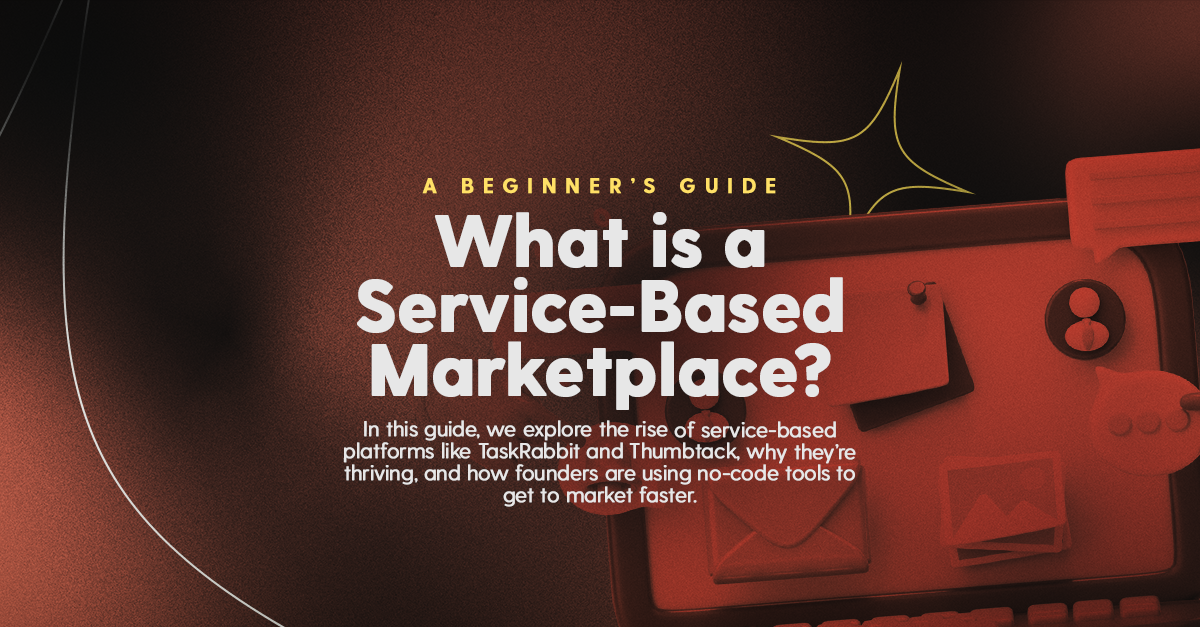Understanding the Marketplace Model in 2025
We’re living in a time where people expect everything — services, support, expertise — on demand and at their fingertips. Whether it’s booking a plumber in your neighborhood, hiring a voiceover artist across the globe, or scheduling a one-on-one virtual wellness session, people now turn to online service marketplaces as their first stop.
These platforms have become the backbone of the convenience economy, reshaping how services are discovered, booked, paid for, and delivered. In a world that values speed, flexibility, and personalization, service marketplaces thrive by connecting the right person to the right task — instantly.
But let’s zoom out a bit.
In 2025, the marketplace model is more than just a clever startup idea. It’s a proven business framework used by companies large and small to unlock growth, streamline service delivery, and tap into the global gig and creator economies. From solo consultants launching micro-marketplaces to venture-backed platforms disrupting billion-dollar industries, the marketplace model has evolved into a strategic powerhouse.
What’s changed? A few key things:
- Technology has matured — making it easier and cheaper than ever to launch a marketplace without a full dev team.
- Remote work is the norm — opening up new possibilities for virtual and global service exchanges.
- Consumers want control — and marketplaces give them that through transparent pricing, ratings, and flexible options.
- Entrepreneurs are niching down — building marketplaces not for everyone, but for specific industries, localities, or communities.
Service marketplaces aren’t just a passing trend. They’re reshaping industries from the ground up — home services, education, healthcare, consulting, coaching, creative work, and everything in between.
So, whether you’re an aspiring founder exploring new business models, an existing business looking to add a digital layer, or simply curious about how the marketplace model really works — this guide will walk you through the essentials. You’ll learn what a service marketplace is, why it matters now more than ever, and how you can start building one that stands out in today’s fast-moving landscape.
What is a Service-Based Marketplace?
A service-based marketplace is an online platform that connects people who need a specific service with those who can provide it — think of it as the digital matchmaker for skills and tasks. Unlike product marketplaces (like Amazon, eBay, or Etsy), where the focus is on physical goods being shipped from sellers to buyers, service marketplaces revolve around time, talent, and expertise.
You’re not buying something you can hold; you’re hiring someone to get something done. That “something” can range from mowing a lawn to designing a logo, teaching a language, walking a dog, or helping with bookkeeping.
In a typical service marketplace, the platform serves as the central hub where:
- Service providers can create a profile, showcase their expertise, and offer their availability.
- Customers can search for providers, compare reviews, browse pricing, and book the service they need.
- Transactions are handled directly through the platform, often with built-in payment processing, messaging, and scheduling tools.
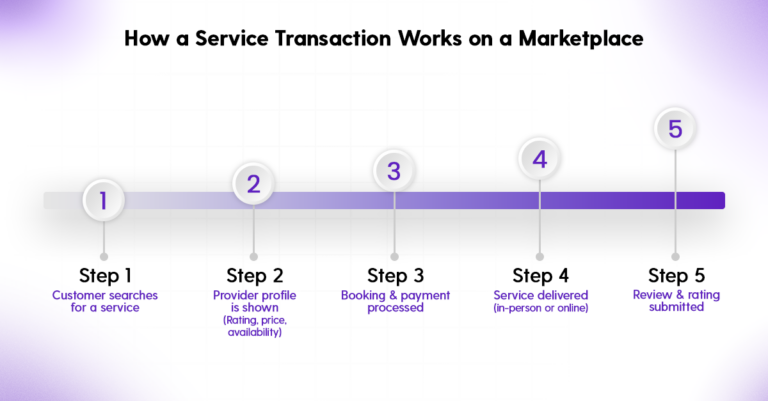
Some services are delivered locally and in person (like home cleaning or photography), while others are digital and remote (like coaching, consulting, or freelance design). Either way, the platform facilitates the connection, sets the ground rules, and often steps in to help resolve disputes or provide buyer protections.
Here are a few examples of service marketplaces you might already know and use:
- Upwork – Connects freelancers with clients in fields like design, development, writing, and marketing.
- TaskRabbit – Helps users find local professionals for errands, furniture assembly, moving, and other hands-on tasks.
- Thumbtack – Offers access to a wide range of local service providers, from photographers and personal trainers to electricians and dog walkers.
- Fiverr – Focuses on micro-gigs and creative services like voiceovers, illustrations, and social media content.
- Rover – A marketplace exclusively for pet services, including dog walking and pet sitting.
- UrbanClap (now Urban Company) – Offers everything from beauty services to appliance repair across major cities.
What these platforms have in common is that they handle the logistics of matching, messaging, payment, and trust — so buyers and providers can focus on the service itself. The service is typically delivered off-platform (like in someone’s home or via Zoom), but everything leading up to it — finding, booking, paying — is handled seamlessly by the platform.
In essence, a service-based marketplace doesn’t sell a product — it empowers people to exchange time, skill, and value. Whether it’s peer-to-peer, business-to-consumer, or business-to-business, the core idea remains the same: the platform connects the dots, and the magic happens from there.
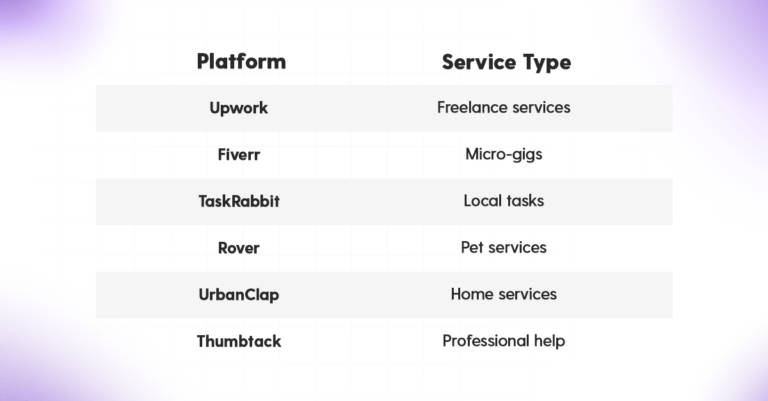
Service Marketplace Revenue Models Explained
One of the biggest advantages of launching a service-based marketplace is the flexibility in how you can monetize it. Whether you’re building a platform for freelancers, local contractors, or niche professionals, there are several time-tested revenue models you can draw from — each with its own advantages and challenges.
Let’s break down the most common monetization strategies and how today’s leading platforms are using them to grow.
Commission-Based Revenue
This is the classic marketplace model. Every time a transaction happens between a buyer and a service provider, the platform takes a percentage. It’s straightforward, scalable, and tightly aligned with platform usage.
Commission-based models are common because they’re easy to implement and offer clear incentives. If your users make money, so do you. Platforms like Upwork and Fiverr take a 10–20% cut of transactions, and it hasn’t slowed them down. Rover goes a step further by charging both pet owners and sitters, capturing value on both sides of the transaction.
That said, this model works best when your platform is the default place where transactions happen. If users can easily circumvent your platform after connecting once, you risk losing that revenue stream. To succeed with commissions, you need strong trust systems, escrow payments, and a reason for users to stick with your platform over time.
Subscription and Membership Models
Instead of charging per transaction, some marketplaces monetize by offering access. This could mean charging providers to be listed or charging users to access premium features, exclusive talent, or faster support.
Thumbtack and Bark, for example, offer subscription plans for professionals who want better visibility or a steady stream of leads. This model is especially appealing in industries where repeat business is common and where users value ongoing access over one-off transactions.
The benefit here is predictable, recurring revenue. The challenge? You have to consistently deliver enough value to justify the monthly or annual cost. If you don’t, you’ll face high churn rates.
Freemium and Tiered Access
A freemium model gives users access to the platform for free, but charges for advanced features or tools. It’s a great way to onboard users quickly and then convert the most engaged ones into paying customers.
Care.com uses this approach by offering basic access for free and charging for features like background checks or profile boosts. Fiverr’s “Business” tier does something similar for clients managing multiple freelancers.
The trick here is to design your platform in a way that free users still get value, but power users clearly see the benefits of upgrading. That upgrade path should be intuitive and tied directly to the user’s success on your platform.
Lead Generation and Pay-Per-Contact
In some marketplaces, especially those focused on local or high-ticket services, monetizing the connection itself makes more sense than waiting for a transaction. That’s where lead generation models come in.
In this model, service providers pay to access customer leads — often before any sale is made. Platforms like HomeAdvisor and Angi have built massive businesses this way. Bark sells credits to providers who want to contact leads directly. Houzz Pro offers paid listings and lead access as part of a broader SaaS toolkit.
This approach can be highly profitable, but only if the leads are good. If providers spend money and don’t convert, they won’t stick around. So you’ll need strong filtering, qualification systems, and analytics to track conversion rates and prove ROI to your users.
Choosing the Right Model (Or Combining Them)
The best part? You don’t have to pick just one. Many successful marketplaces combine these models to serve different user segments and stages of the customer journey. For example, you might offer:
- Freemium access to attract users
- Subscription tiers for power providers
- A small commission on completed bookings
- Optional paid boosts for visibility or lead priority
The key is to align your monetization strategy with your users’ behavior and the real value your platform delivers. As your marketplace evolves, you can test and refine your model based on what drives growth and retention.
Monetization Is the Engine — But Strategy Is the Fuel
Ultimately, how your marketplace makes money will shape the kind of users you attract, the way they interact, and the long-term sustainability of your platform. It’s not just about charging fees — it’s about creating a system where everyone wins: buyers get quality services, providers get steady work, and your platform earns as a result.
If you’re serious about launching a marketplace, thinking through your monetization strategy from day one isn’t optional — it’s essential.
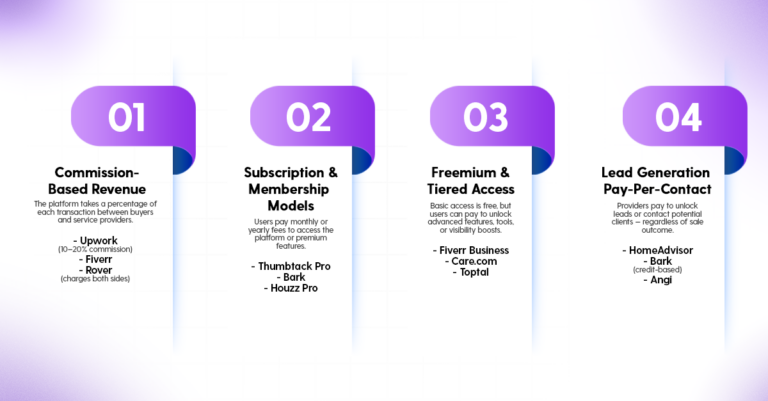
Why Service Marketplaces Are Booming Right Now
While service marketplaces have been around for a while, their rise over the past few years has been nothing short of explosive. What once felt like a niche or experimental model is now a mainstream business category — fueling everything from side hustles to multi-billion-dollar platforms. But this growth isn’t random. It’s being driven by some powerful, global shifts that have fundamentally changed how people work, hire, and consume services.
Let’s break down why the timing for service marketplaces is not just good — it’s phenomenal.
The Rise of the Gig and Freelance Economy
We’re living through a global shift in how people think about work. More professionals are leaving the 9-to-5 grind in favor of freelance, contract, and project-based roles. It’s not just creatives anymore — developers, consultants, marketers, coaches, and even healthcare providers are embracing flexible work.
Platforms like Upwork, Fiverr, and Toptal have made it easy for independent workers to find clients — and just as easy for businesses to hire on demand. This model is efficient, scalable, and appealing to both sides of the equation.
But more importantly, it’s creating a massive supply of skilled service providers who are looking for digital platforms to market their work. That’s your opportunity.
Mobile-First, On-Demand Culture
Consumers today expect services to be as instant and seamless as ordering a ride or a pizza. Thanks to platforms like Uber and Instacart, people have gotten used to tapping a button and getting what they need — now.
That on-demand expectation is spreading to every service category:
- Need a cleaner today? Book through Handy.
- Want a virtual personal trainer? Tap into an app.
- Looking for someone to assemble IKEA furniture? TaskRabbit has you covered.
Mobile apps and push-to-book UX have removed so much friction from the service delivery process that users now seek this kind of convenience by default.
The Globalization of Services
We’re no longer limited by zip codes or time zones. Thanks to remote work tools, video conferencing, and cross-border payments, service marketplaces can now connect talent and clients across continents.
A UX designer in India can work with a startup in Berlin. A nutrition coach in Canada can help clients in the UAE. A tutor in Nigeria can teach English to students in South Korea.
For founders, this means your marketplace can start local and scale global, or go global from day one. The playing field is wide open.
Investor Confidence & Startup Scalability
Let’s talk business. Investors love marketplaces — especially when they’re lean, scalable, and asset-light. Unlike product marketplaces that deal with inventory, warehouses, or shipping logistics, service platforms don’t require physical goods to function.
This means they can scale faster, enter new markets more easily, and adapt quicker to user feedback.
For founders, that means fewer upfront costs and a much faster time to launch. For investors, it means platforms that can deliver network effects without getting bogged down in operations.
That’s why VC-backed service marketplaces continue to dominate headlines — because they work.
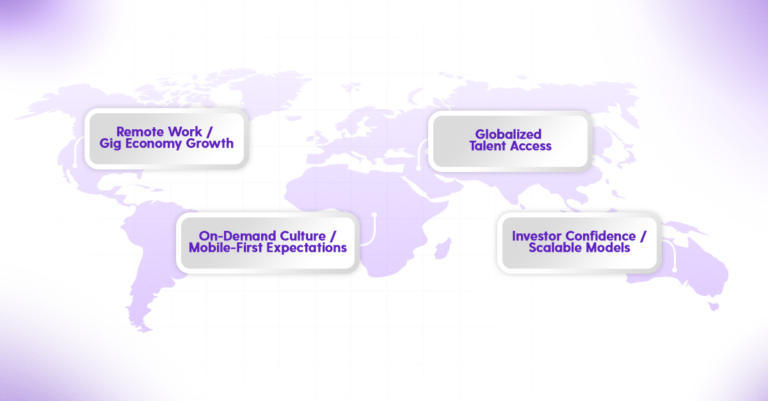
Why Entrepreneurs Should Pay Attention
If you’re an entrepreneur looking for your next big move, service marketplaces are a goldmine of opportunity. Why? Because the demand is already there. People everywhere are looking for easier, faster, and more reliable ways to hire help—whether it’s a freelance designer, a dog walker, or a home cleaner.
Unlike many startup ideas that require you to create demand from scratch, marketplaces tap into existing behavior. Services like Upwork, Thumbtack, and TaskRabbit have already validated the model — you don’t have to reinvent the wheel.
What’s more, the barriers to entry have never been lower. Thanks to no-code tools like Dittofi, you can go from idea to live platform without writing a single line of code. That means you can move fast, test ideas quickly, and scale when you see traction — all without a full dev team or massive upfront costs.
Even better, service marketplaces are ideal for carving out niche opportunities. You don’t need to compete with Upwork or Uber to win. You can build something hyper-targeted:
- A local platform for eco-friendly home cleaning services
- A B2B marketplace that matches startups with expert consultants
- A virtual coaching app focused solely on women in tech
And here’s the magic: as more users join, the value of your platform grows. That’s the network effect in action — where every new user adds value for everyone else.
The Bottom Line
At the end of the day, a service-based marketplace is so much more than just a list of providers. It’s a dynamic ecosystem — a platform that brings people together to solve problems, deliver services, and create value in real time.
These marketplaces are transforming how we work, hire, learn, and live. They offer flexibility for providers, convenience for users, and a scalable business model for founders. And with today’s tech, building one isn’t just possible — it’s faster and more accessible than ever.
Whether your vision is to create the next big gig economy platform or to dominate a niche local service category, the tools are here, the timing is right, and the opportunity is wide open.
And the best part?
You don’t need to be a developer to make it happen.
Ready to Build a Marketplace Like TaskRabbit or Fiverr?
Skip the dev team. Dittofi lets you launch scalable, secure platforms — fast.

